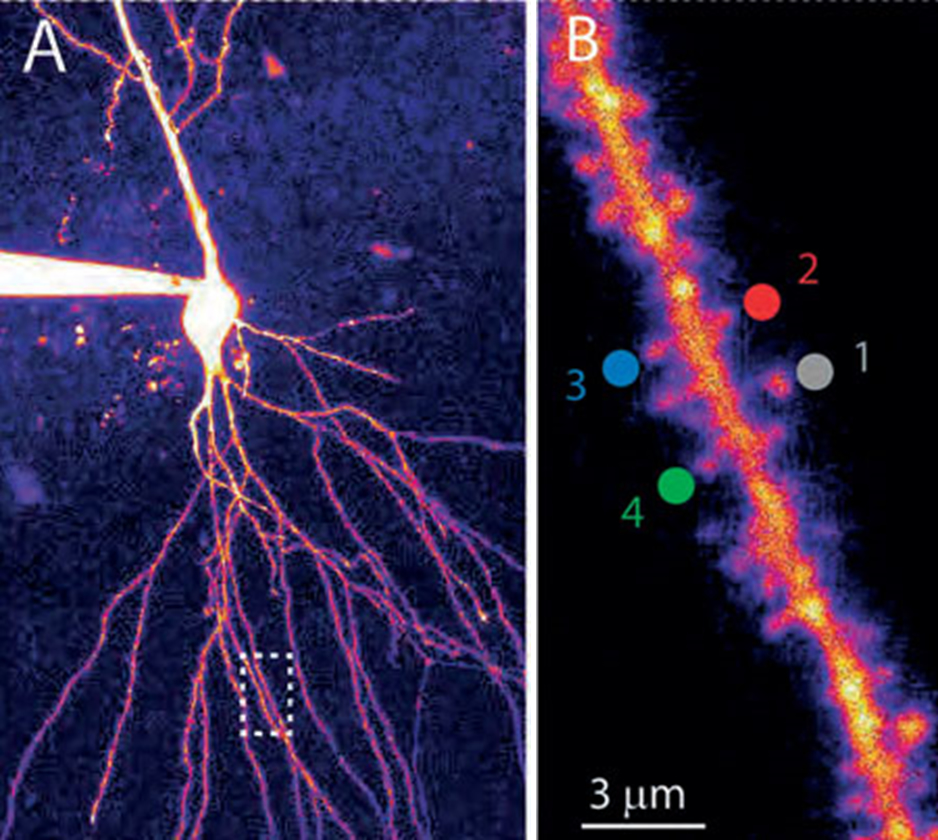The title of your ERC project highlights the link between dendrites (the extensions of nerve cells) and memory. It immediately arouses interest as everyone is curious about how memory works – though the word ‘memory’ rarely invokes the image of the branch-like extensions of nerve cells.

Judit Makara
Well, my journey toward memory started specifically from the world of dendrites. I have been studying dendrites for more than ten years in brain slices under the microscope and based on the results we are setting up hypotheses about their use for nerve cells.
Of course, we know already that dendrites receive most of the information coming to the neuron from other cells through connections (synapses). Most cortical neurons have extensive dendritic trees enabling them to receive up to ten to twenty thousand synaptic inputs. Dendrites themselves also have electrical properties which affect how signals from different synapses interact with each other and how they get to the soma where the output signal is generated. Dendrites can express a variety of voltage sensitive ion channels and if many synapses begin to ring at once, and provide sufficiently strong voltage response, this can activate certain ion channels in the dendrite. They can influence the received signal and ultimately even the output signal, the encoding - which may be connected for example to learning and memory.
Where do these processes take place?
Lately, we have been examining the role of dendrites in neurons of the so-called CA3 region of the hippocampus (a brain area located in the temporal lobe). The hippocampus plays a central role in the storage and recalling of traces of episodic memory (about events linked to a given place, environment and time). One assumption is that the part of the hippocampus where our measurements take place may play a role in separating and completing neuronal activity patterns. We have just started our journey from trying to understand the function of individual nerve cells toward trying to understand the neuronal network mechanisms of learning and memory.
Dendrites have shifted into the focus of research only recently.
Partly because they are very thin structures and it is difficult to study their function. When I worked as a postdoctor in the USA, I learned a technique of stimulating synapses of a given neuron artificially in different patterns in brain slices. This enables detailed mapping of how specific dendrites can contribute to the transmission of signals. We also demonstrated previously that the properties of dendrites can be modified: cells can “learn” how to regulate their dendrites to be more or less excitable. Therefore the integrated signals coming from the synapses can be amplified (or weakened); that is, the neuronal response can be tuned via its dendrites.
 |
| A neuron visualized by fluorescent dye (in a previous study). One of the dendrites marked by a rectangle in figure A is magnified in figure B. In the experiment the numbered dendritic spines were stimulated. |
What is the novelty of your ERC project?
The main novelty, in my opinion, is that the processes so far examined in brain slices will be followed in live animals – while they are “doing things”, moving in space, trying to remember where they are and where they will be rewarded – to understand what happens locally in the dendrites during cognitive processes, and we will also use some new experimental procedures for this. Although there are more and more cell and dendrite level data using in vivo high-resolution imaging in the hippocampus, these mainly focused to other regions.
The ERC grant is provided for projects which are “risky” in terms of the outcome but have the potential to produce important results. Your research project does not seem too risky as every new piece of information is important for understanding the processes relating to the memory.
Yes, I also think that the project’s results will be informative irrespective of whether they confirm or refute the existing theories. The classical theories concerning the operation of the CA3 network rarely take into consideration the function of dendrites, so they try to model mechanisms only on the basis of the relationship between the signals received through the synapses and the cells: as if the dendrite was a kind of a passive “black box”. The worst-case scenario is that these theories are correct, but I do not think so.
Connecting the results of experiments in brain slices and live animals, however, is indeed riskier. The electrical properties of dendrites greatly vary in brain slices. But it is a question whether this diversity exists, or can result from activity, in the live animal - is there plasticity, ability to change? If so, it may suggest that in live nerve cells in the brain the excitability and operation of the dendrites can be fine-tuned and this influences the extent to which they participate in neuronal response and encoding – in learning.
In medical research the question always arises: will the new knowledge be applied to treat patients?
This is what everyone wants, but it is difficult to intervene in the operation of an extremely complex structure – the brain - in a way that only the selected mechanism is affected.
Yet, if we managed to find out what dendrites are good for, it would be interesting to examine in a later project how the function of neurons changes in animal models of slight memory impairment or aging. If the hypothesis that dendrites also represent a distinct signal processing level between the cell input and output proves to be true, this level may also be impaired. This has not really been taken into account so far – but the expected results may still “only” be enough to better understand how a system works and goes wrong.
So, the group has much to do.
The mission is not impossible but due to the many tasks I would like to bring in new talented members to my research group, which currently consists of three postdoctors, a PhD student, a technician and university students.
How did the NRDI Office’s bridge funding help in winning the ERC grant?
The bridge funding helped me to maintain my lab in the past two years, alter the previous project proposal based on fresh research results, shift the focus to other questions and undertake to perform in vivo measurements. I think the bridge funding is an excellent initiative because the focused funding gives motivation and can really increase the chance of winning an ERC grant.






